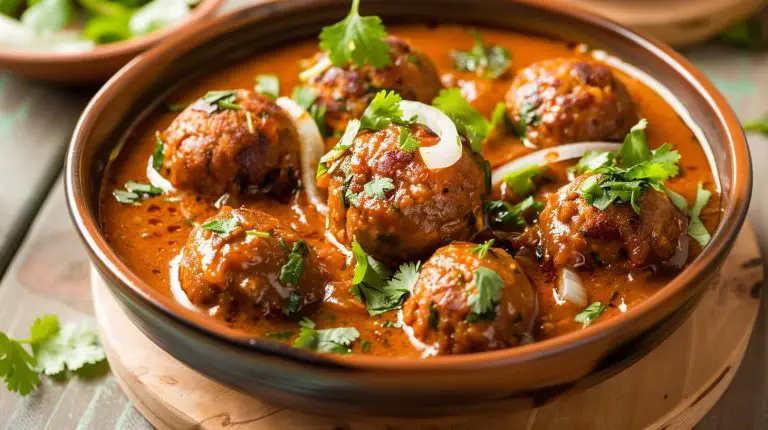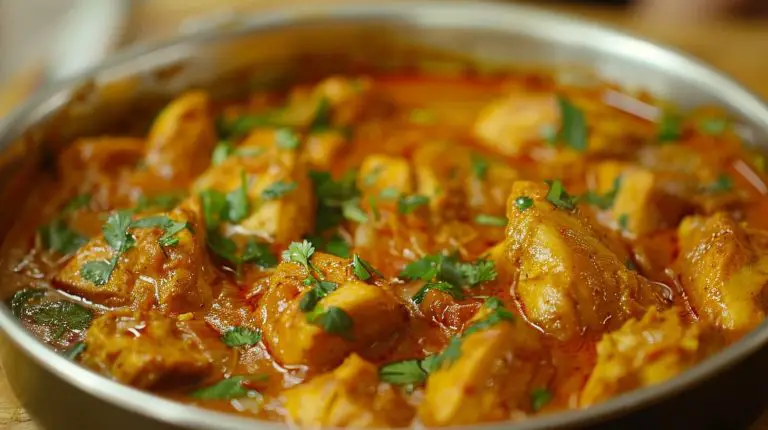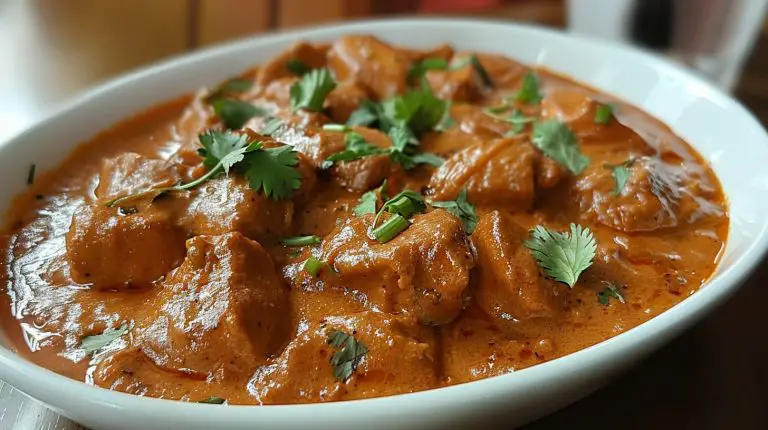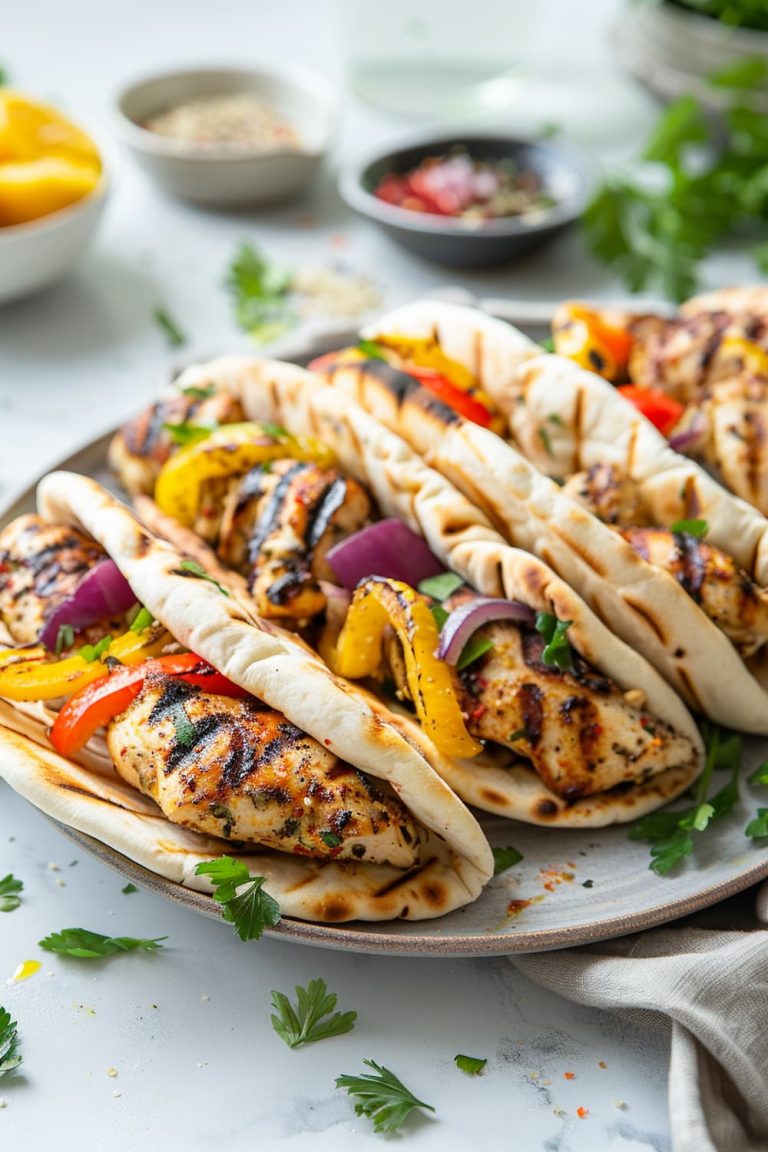Easy Indian-Spiced Fried Chicken Recipe
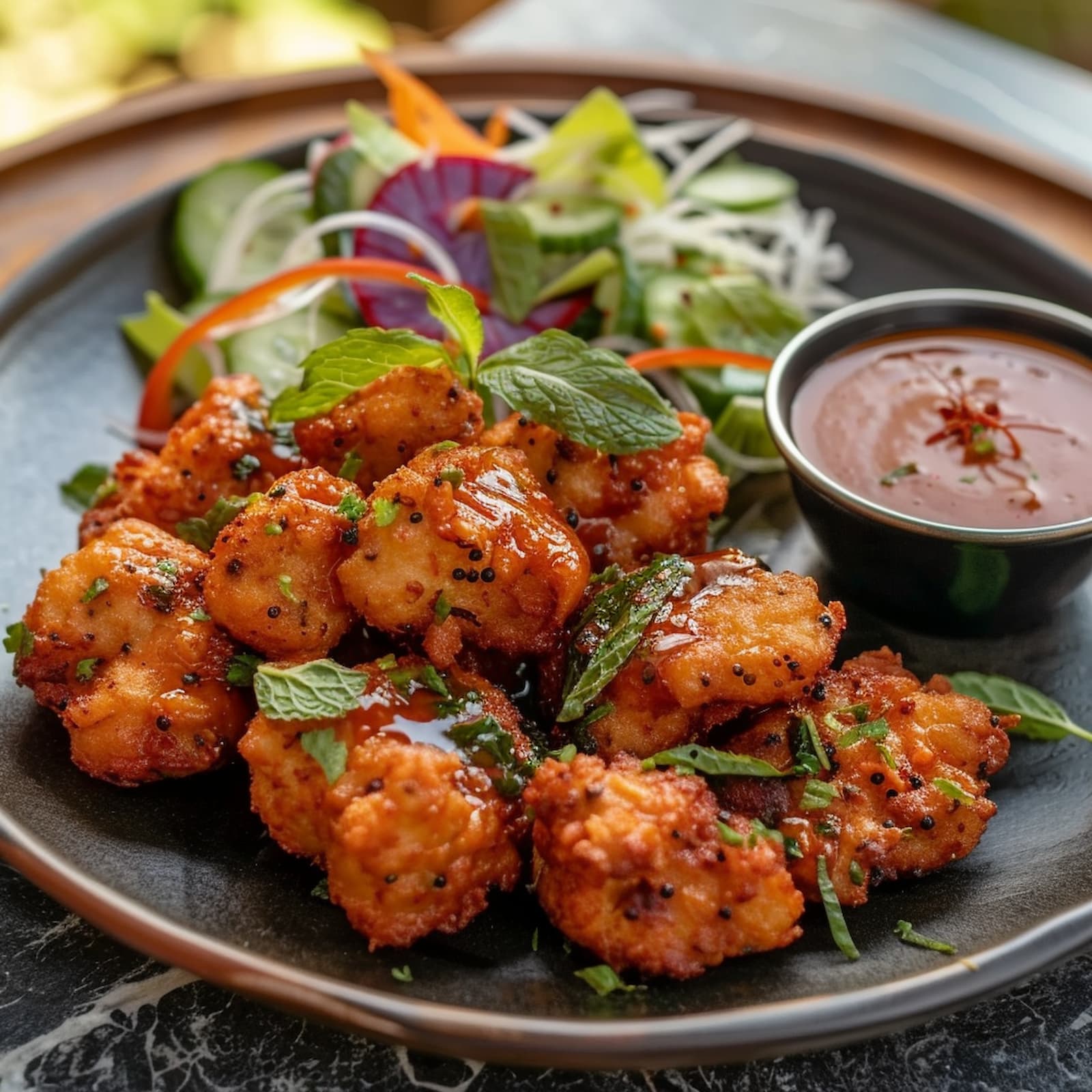
Fried chicken holds a significant place in many cultures, especially in the American South, where it’s synonymous with family gatherings, Sunday dinners, and communal celebrations.
It’s a dish that carries with it a sense of comfort and nostalgia, often featured at picnics, barbecues, and holiday meals.
In this guide, you’ll learn
- Interesting Facts About Fried Chicken Recipes
- How to make Crispy Fried Chicken Recipe in your kitchen
- Healthy Vegan Alternatives For The Items Used In the Recipe
- Common Mistakes To Avoid, Pro Tips To Enhance The Taste Of the Dish
- FAQs (Reader Questions Answered) and much more stuff!
So, grab your apron, and let’s dive in!
Origins and Cultural Significance of Fried Chicken Recipe:
The concept of frying chicken in fat has roots across many cultures, but the version most are familiar with today—seasoned, coated, and deep-fried chicken—has its origins in the American South.
- Scottish immigrants brought their tradition of deep-frying chicken, while the African Americans, introduced the seasoning aspect, combining to create the soulful dish known today as Southern fried chicken.
- This culinary fusion, born out of necessity and resourcefulness, quickly became a staple in American cuisine.
Regional Variations of Fried Chicken Recipe:
- American South: Traditionally marinated in buttermilk and coated in seasoned flour before frying.
- Korea: Known as “yangnyeom chicken,” it’s double-fried for extra crispiness and coated in a sweet and spicy sauce.
- Japan: “Karaage” involves marinating bite-sized pieces of chicken, coating them in flour or starch, and frying them to achieve a light, crispy texture.
- Italy: “Pollo fritto” often sees the chicken marinated in lemon and herbs, coated in a simple batter, and fried. Each region adapts the dish to local tastes and available ingredients, creating a diverse spectrum of flavors and textures.
Fun Facts about Fried Chicken Recipe:
- World Records: The world’s largest serving of fried chicken was prepared in Japan (Nakatsu), weighing over 1,667.301 kilogram (3,675 lb 12 oz) in 2019.
- A Presidential Favorite: Fried chicken was known to be a favorite dish of President Thomas Jefferson.
- Global Love: July 6th is celebrated as National Fried Chicken Day in the United States, marking the dish’s enduring popularity and cultural significance.
How to make Awesome Fried Chicken Recipe As A Beginner
Ingredients:
- 4 chicken breasts (boneless, skinless) – for a leaner, digestible option
- 1 cup almond flour (as a gluten-free alternative to traditional flour)
- 2 tsp turmeric powder (for its anti-inflammatory properties)
- 1 tsp garam masala (a blend that adds warmth and depth)
- 1 tsp cumin powder (for a smoky hint)
- 1 tsp coriander powder (adds a citrusy undertone)
- 1/2 tsp Red chili powder (adjust according to heat preference)
- 1 cup coconut milk (a dairy-free substitute to soak the chicken)
- 2 tbsp lemon juice (for a tangy kick)
- Salt to taste
- 2 tbsp Olive or Coconut oil for frying (a healthier, high-heat option)
Instructions
Getting the Chicken Ready
Start with the Chicken Breasts:
- Lay each chicken breast flat on your cutting board.
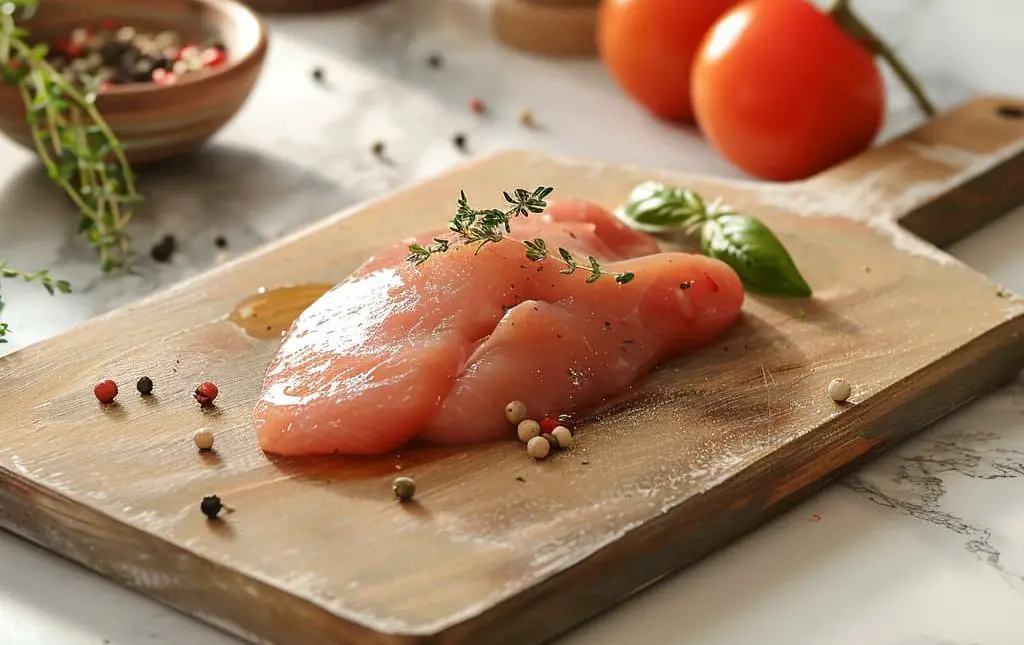
- If they’re thick, you might want to slice them horizontally into thinner pieces.
- This helps them cook more quickly and evenly. Then, put each piece between two sheets of parchment paper or in a plastic bag.
Flatten the Chicken:
- Using a rolling pin or the flat side of a meat mallet, gently pound the chicken to even thickness, about ½ inch or so.
- This isn’t just for uniform cooking; it also tenderizes the meat, making it softer and easier to eat.
Marinating for Flavor
Create Your Marinade:
- In a bowl, mix the coconut milk with lemon juice, half of your turmeric, and the other spices (garam masala, cumin, coriander, chili powder, and a bit of salt).
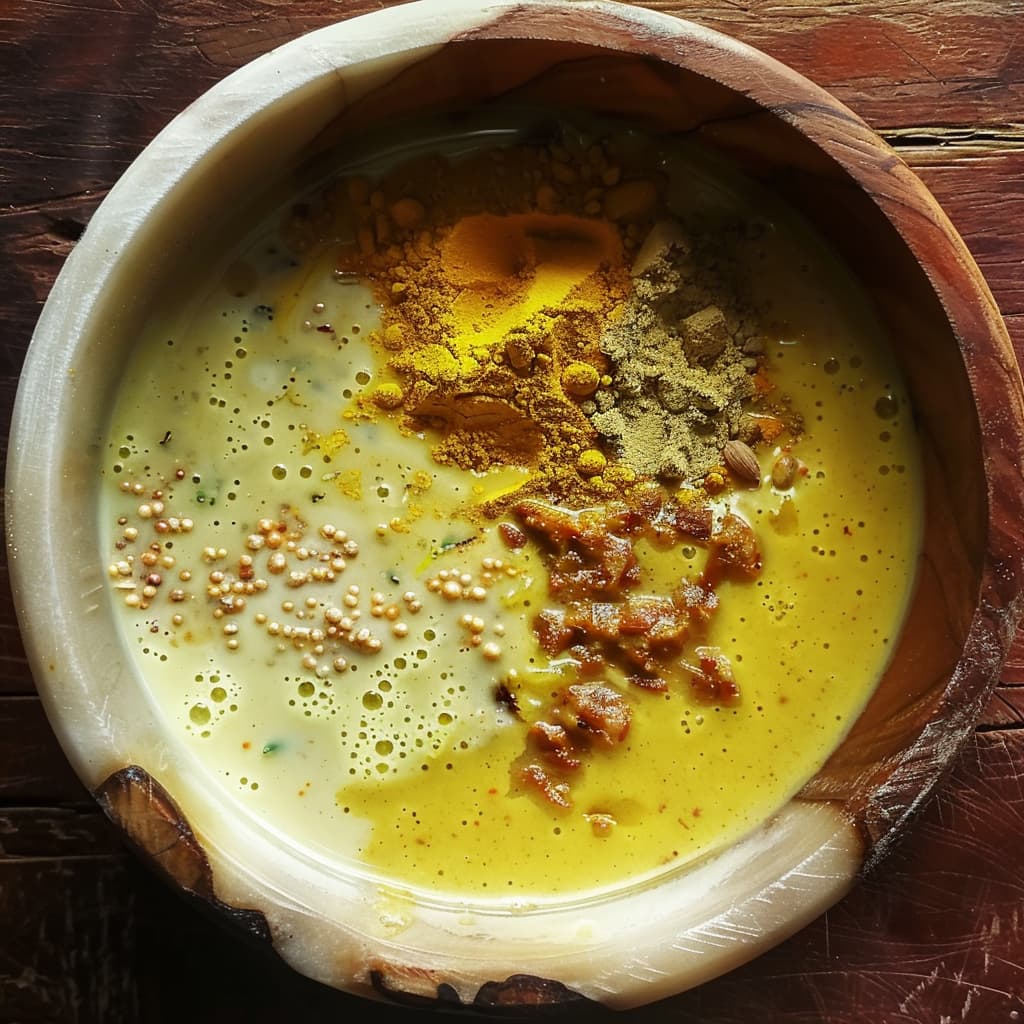
- This mix is going to give your chicken an incredible depth of flavor and a tender texture.
Marinate the Chicken:
- Place your chicken pieces in the marinade, ensuring each piece is well-coated.
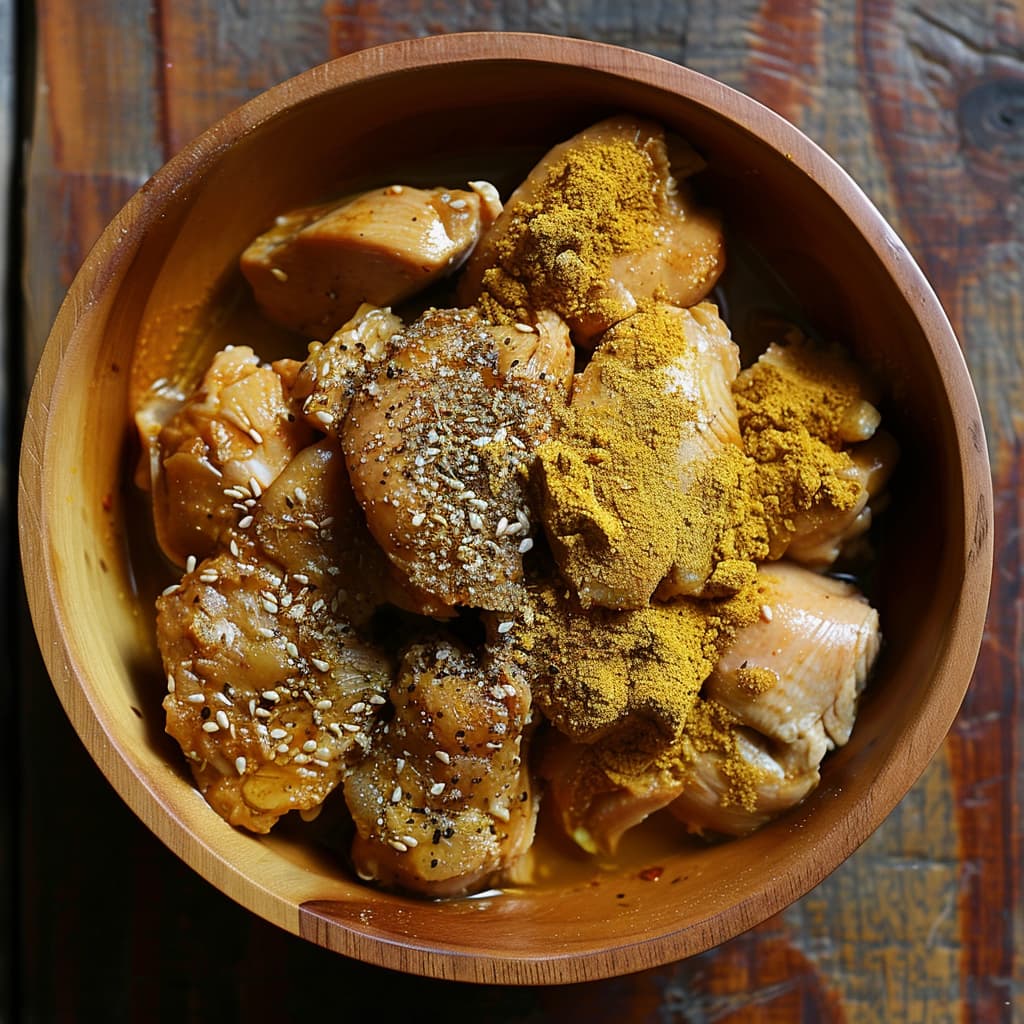
- Cover the bowl with plastic wrap or a lid and refrigerate. If you’re short on time, 30 minutes will work, but if you can leave it longer than that, say for multiple hours, you’ll be rewarded with even more flavorful chicken.
Coating for Crunch
Prepare the Coating:
- Mix the almond flour with the remaining turmeric and a little extra salt in a shallow dish.
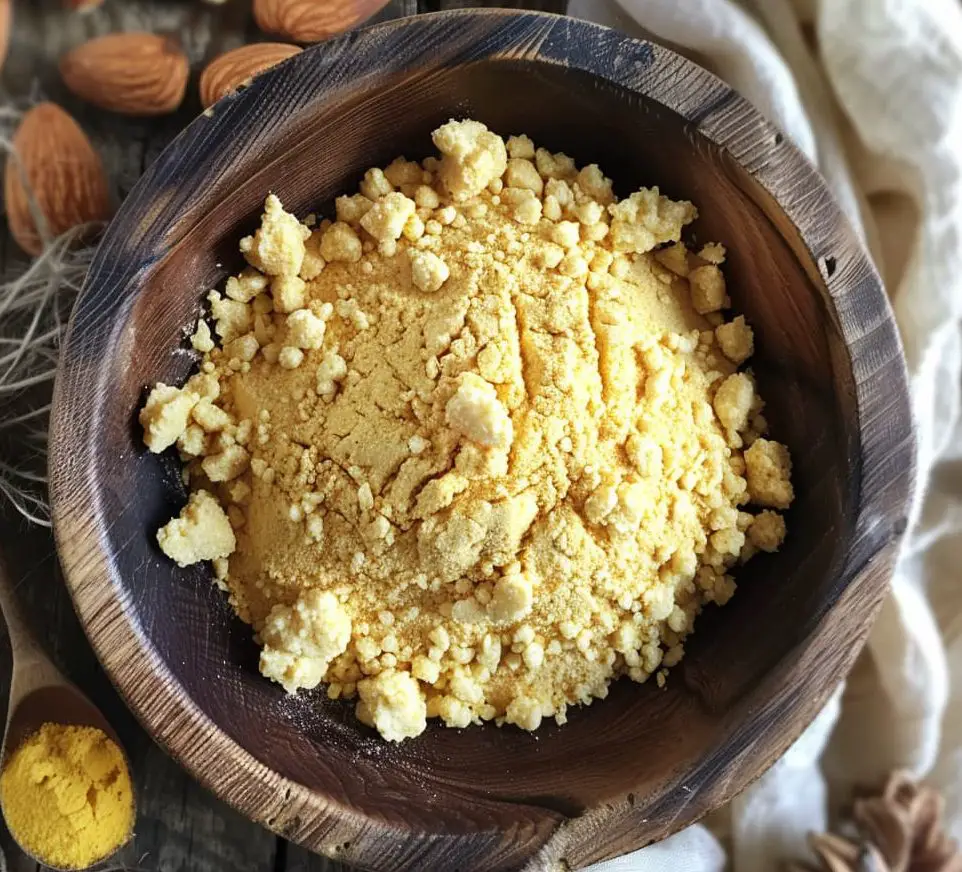
- If you saved any spice mix from the marinade step, add that in too. This is what’s going to give your chicken that irresistible crunch.
Coat the Chicken:
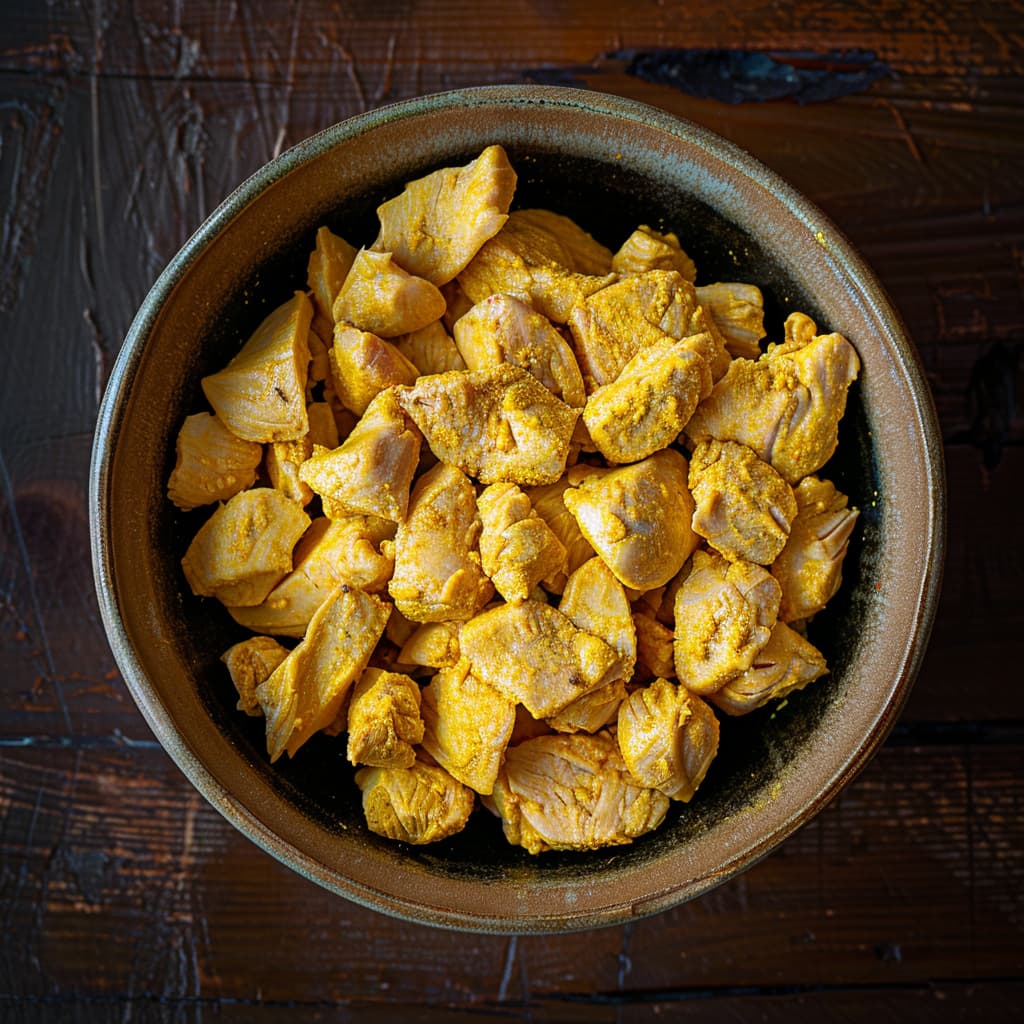
- Take each piece of marinated chicken, letting the excess liquid drip off, then dredge it in your almond flour mixture until it’s completely covered.
- This is a key step for achieving that nice, crunchy exterior we’re aiming for.
Frying to Perfection
Heat the Oil:
- In a large skillet, heat 2 tbsp of olive oil over medium heat.
- You’re looking for the oil to be hot enough that it sizzles when you add the chicken, but not so hot that it smokes.
Fry the Chicken:
- Gently lay the coated chicken pieces in the hot oil.
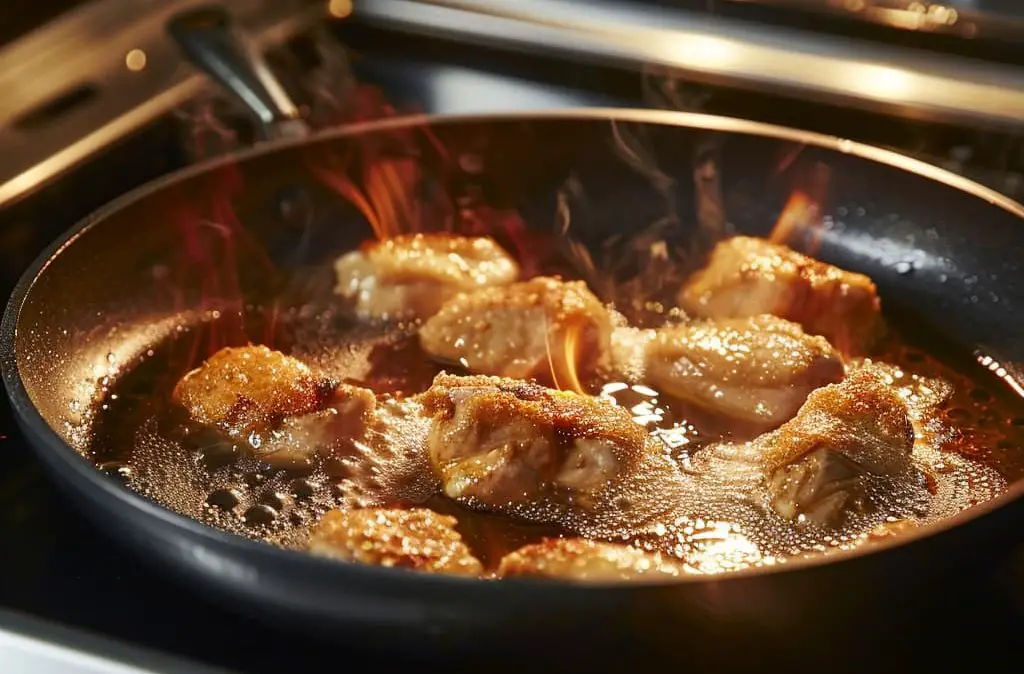
- Fry them for about 4-5 minutes on each side.
- You’re aiming for a golden brown color and an internal temperature of 165°F.
- Use tongs to turn the chicken; this will help you avoid tearing the coating.
Rest Before Serving:
- Once cooked, transfer the chicken to a plate lined with paper towels to soak up any excess oil.
- Letting it rest for a few minutes before serving helps keep the juices in, making your chicken moist and flavorful.
Serving
Serve your chicken hot, garnished with mint leaves with sauce or chutney mix and some light salad or some sautéed vegetables.
The contrast of flavors and textures will make for a delightful meal.
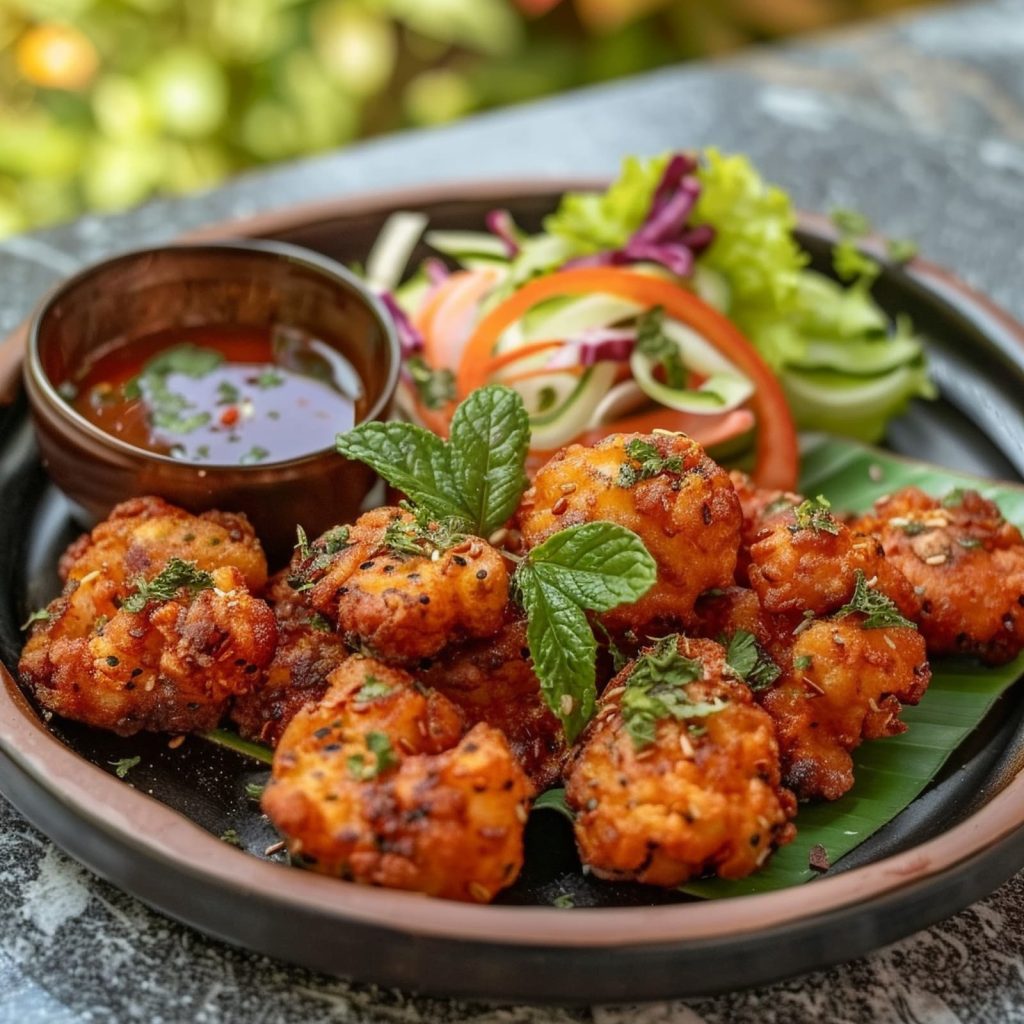
Vegan Alternatives and How to Make the Whole Prep more Healthy
For the “Chicken”:
- Tofu: Extra-firm tofu, when pressed and marinated, can provide a good base for frying. Freezing and thawing tofu before use can also give it a chewier texture.
- Cauliflower: For a whole-food option, cauliflower florets can be battered and fried, offering a satisfying crunch and a neutral canvas for flavors.
- Jackfruit: Young green jackfruit has a texture similar to shredded chicken and is excellent for mimicking chicken pieces in recipes requiring a pulled texture.
- Tempeh: Tempeh’s firm texture and nutty flavor make it a nutritious base for vegan fried “chicken.” Slicing and marinating it well ensures it’s flavorful.
For the Batter:
- Chickpea Flour: A great substitute for eggs in the batter, chickpea flour can be mixed with water to create a thick paste that helps the breading stick to your vegan “chicken.”
- Aquafaba: The liquid from canned chickpeas mimics the viscosity of egg whites and is perfect for creating a light batter when whipped.
- Almond Milk: Unsweetened almond milk can replace cow’s milk in the batter. Add a little apple cider vinegar to it to mimic buttermilk’s tanginess.
Mistakes To Avoid
Ingredient Selection:
- Common Mistakes: Using old spices or incorrect substitutes. Spices are crucial in Indian cooking; however, their flavors diminish over time. Additionally, substituting unique spices like garam masala or turmeric with non-similar spices can significantly alter the dish’s intended flavor profile.
- How to Avoid: Always opt for fresh, high-quality spices. If a recipe calls for a specific Indian spice blend or ingredient that you don’t have, try to find the closest possible match or make your own blend. Avoid using generic substitutes if the unique flavor is central to the dish.
Preparation Pitfalls:
- Common Mistakes: Over-marinating or under-marinating the chicken, and not properly tenderizing or cutting the chicken if required. These steps are crucial for flavor infusion and cooking the chicken evenly.
- How to Avoid: Follow the marinating time recommended in the recipe closely—typically, a few hours to overnight for optimal flavor. If the recipe calls for tenderizing or cutting the chicken into specific sizes, do so carefully to ensure even cooking and maximum flavor absorption.
Cooking Techniques:
- Common Mistakes: Cooking at the wrong temperature or overcrowding the pan. Too high a temperature can burn the spices without properly cooking the chicken, while too low a temperature can lead to greasy chicken. Overcrowding the pan can steam the chicken instead of frying, leading to soggy breading.
- How to Avoid: Use a thermometer to ensure your oil is at the correct temperature, usually between 350°F to 375°F (175°C to 190°C) for frying. Cook in batches if necessary to avoid overcrowding and ensure each piece is properly fried to a crispy, golden brown.
Seasoning and Flavoring:
- Common Mistakes: Under-seasoning or over-seasoning. It’s easy to under-season, thinking the spices alone will carry the dish, or to over-season, making it too salty or overpowering in one flavor dimension.
- How to Avoid: Taste your marinade and adjust seasonings as necessary before adding the chicken. Remember, you can always add more seasoning later, but you can’t take it away once it’s there. Balance the spices with the saltiness and acidity to achieve a harmonious flavor profile.
Presentation Tips:
- Common Mistakes: Neglecting the visual appeal of the dish. Indian cuisine is not just about taste; it’s also about presentation. A cluttered or monochromatic presentation can detract from the dish’s appeal.
- How to Avoid: Serve your fried chicken on a platter with fresh herbs like cilantro or slices of lime for a pop of color. Consider adding a side of bright chutney or a simple salad to complement the richness of the fried chicken and add visual interest to the plate.
Pairing Suggestions for Fried Chicken
- Beverages: Complement the rich spices of Indian-Spiced Fried Chicken with refreshing beverages. A crisp, cold lager or a citrusy wheat beer cuts through the spice, while a mango lassi or ginger-infused lemonade offers a non-alcoholic refreshment that balances the dish’s heat.
- Side Dishes: Opt for sides that offer a cooling contrast or enhance the dish’s flavors. A cucumber raita or a mint chutney provides a refreshing counterpoint, while a light, lemony couscous or a bowl of fragrant basmati rice can serve as a neutral base to the chicken’s robust flavors. A side of sautéed greens or a simple kachumber salad (diced cucumber, tomato, onion, and lemon juice) adds freshness and crunch.
- Other Main Courses: If serving as part of a larger meal, pair with dishes that share a flavor affinity but vary in texture and preparation, such as lentil dal, vegetable biryani, or grilled paneer skewers. This variety offers a well-rounded and satisfying dining experience.
Always Keep In Mind, that the inclusion of newer veggies or spices can end up impacting the overall taste of the dish, so you may need to adjust your other spices or salt portions to counter that.
Common Problems You May Face While Cooking Fried Chicken
If you’re new to cooking, especially with something as flavor-packed and technique-driven as Indian-Spiced Fried Chicken, it’s easy to encounter a few hiccups along the way. Don’t worry! Here’s a friendly guide to help you navigate and solve these common problems, ensuring your cooking experience is both enjoyable and successful.
Problem 1: Burning the Spices
- Solution: Spices can burn quickly, especially if frying on high heat. To prevent this, make sure your oil is hot, but not smoking, before adding the chicken. Cook on medium-high heat, and don’t leave the pan unattended. If the spices are browning too quickly, lower the heat.
Problem 2: The Chicken Isn’t Cooking Evenly
- Solution: Cut the chicken into even-sized pieces so they cook at the same rate. Avoid overcrowding the pan; cook in batches if necessary. This ensures each piece is properly fried and cooked through evenly.
Problem 3: The Coating Isn’t Crispy
- Solution: Ensure your oil is at the correct temperature (around 350°F to 375°F) before adding the chicken. If the oil isn’t hot enough, the chicken will absorb it, resulting in a soggy coating. Use a thermometer to check the oil’s temperature.
Problem 4: The Chicken Is Dry or Overcooked
- Solution: Use a timer to avoid overcooking. Depending on the size, chicken pieces typically take about 7-10 minutes to fry. Remove a piece and check for doneness by cutting into it; the juices should run clear, and the inside should no longer be pink.
Tips for Perfecting Fried Chicken Recipe
- Marinade Mastery: For an extra tender and flavorful chicken, use full-fat yogurt in your marinade. The acidity in the yogurt gently breaks down the proteins, tenderizing the chicken, while its fat content adds moisture, ensuring your chicken stays juicy even after frying.
- Spice Toasting Technique: Before grinding your spices for the marinade or the coating, lightly toast them in a dry pan. This step releases the essential oils, deepening the flavors and adding a new dimension to your dish. Cool them before grinding to preserve the oils’ integrity.
- Optimal Oil Temperature: Maintain the oil temperature between 350°F to 375°F (175°C to 190°C) for frying. Use a digital thermometer to monitor. This range is crucial for achieving a crispy exterior without absorbing too much oil or burning the spices.
- Resting Before Serving: Let the fried chicken rest on a wire rack for a few minutes after frying. This allows the juices to be redistributed and the coating to set, ensuring each bite is crispy and moist. Avoid paper towels as they can cause steam buildup, making the crust soggy.
- Presentation Perfection: Enhance the visual appeal by serving on a colorful platter with garnishes like fresh cilantro, lime wedges, and thinly sliced onions marinated in lemon juice and salt. These not only add color but also provide a refreshing contrast to the rich flavors.
- Ingredient Authenticity: Where possible, source authentic Indian spices or spice blends from an Indian grocery store. The quality and authenticity of the spices can significantly affect the dish’s flavor profile.
FAQs about Fried Chicken Recipe (Reader Questions Answered)
1: What if I don’t have all the spices mentioned in the recipe?
- Solution: If you’re missing a specific spice, look for an alternative that has a similar flavor profile. For instance, if you don’t have garam masala, you might use a blend of cumin, coriander, and a pinch of cinnamon as a substitute. Online spice substitution charts can be handy for finding alternatives.
2: Can I make this recipe with boneless chicken?
- Solution: Absolutely! Boneless chicken can be used and will cook faster than bone-in pieces. Just keep an eye on the cooking time as it may need to be adjusted downward to avoid overcooking.
3: How can I make a gluten-free version of this dish?
- Solution: For a gluten-free version, substitute all-purpose flour with a gluten-free flour blend or use chickpea flour for the coating. Both options will give you a delicious, crispy exterior without the gluten.
4: Is there a way to make this dish less spicy for children?
- Solution: Yes, you can reduce the amount of chili powder or use a milder paprika to lower the heat level. You could also increase the yogurt in the marinade to help mellow out the spices further.
5: What’s the best way to reheat leftovers without drying out the chicken?
- Solution: Reheat leftovers in an oven or toaster oven at 350°F (175°C) for about 10 minutes, or until heated through. This method helps retain the chicken’s moisture better than microwaving.
6: Can I use an air fryer instead of deep-frying?
- Solution: Yes, an air fryer is a great alternative for a healthier version. Cook the chicken at 400°F (200°C) for about 15-20 minutes, turning halfway through the cooking time. Ensure the chicken pieces are not overcrowded to allow for even cooking and crispiness.
7: How can I ensure my fried chicken is crispy on the outside and juicy on the inside?
- Solution: Make sure your oil is hot enough before adding the chicken (around 350°F to 375°F), and don’t overcrowd the pan. Marinating the chicken in yogurt helps tenderize it, ensuring it stays juicy during cooking.
8: What can I do if my chicken is cooked on the outside but still raw inside?
- Solution: If you find the chicken is browning too quickly on the outside but isn’t cooked through, lower the heat and cover the pan to allow the chicken to cook through more gently. Alternatively, you can finish cooking the chicken in a preheated oven at 350°F (175°C) until it reaches the proper internal temperature.
9: How do I know when the oil is at the right temperature for frying?
- Solution: Use a kitchen thermometer to check the oil’s temperature. If you don’t have one, you can test the oil by adding a small piece of bread or a drop of batter; it should sizzle and start to brown within a minute if the oil is hot enough.
10: Can I marinate the chicken for longer than the recipe suggests?
- Solution: Marinating the chicken for longer can result in more tender and flavorful meat, but be cautious not to marinate for too long, especially if your marinade contains acidic ingredients like lemon juice, as it can start to “cook” the chicken and affect its texture. Up to 12 hours is usually fine for most marinades.
11: Can I use chicken breast instead of thighs?
- Yes, you can use chicken breast, but keep in mind that breasts are leaner and can become dry if overcooked. Consider reducing the cooking time slightly and ensuring the oil temperature is correct to avoid drying out the meat.
12: What are the best sides to serve with Indian-Spiced Fried Chicken?
- Light and refreshing sides balance the richness of the fried chicken. Consider a cucumber salad, dal (lentil soup), or a simple rice pilaf. These sides complement the spices without overwhelming the palate.
13. Is there a gluten-free option for the coating?
- For a gluten-free coating, substitute all-purpose flour with rice flour or a gluten-free flour blend. These alternatives provide a crispy texture similar to traditional coatings without gluten.
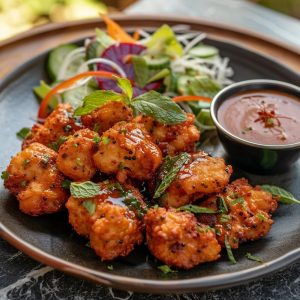
Easy Indian-Spiced Fried Chicken Recipe
Ingredients
- 4 chicken breasts boneless, skinless - for a leaner, digestible option
- 1 cup almond flour as a gluten-free alternative to traditional flour
- 2 tsp turmeric powder for its anti-inflammatory properties
- 1 tsp garam masala a blend that adds warmth and depth
- 1 tsp cumin powder for a smoky hint
- 1 tsp coriander powder adds a citrusy undertone
- 1/2 tsp Red chili powder adjust according to heat preference
- 1 cup coconut milk a dairy-free substitute to soak the chicken
- 2 tbsp lemon juice for a tangy kick
- Salt to taste
- 2 tbsp Olive or Coconut oil for frying a healthier, high-heat option
Instructions
Getting the Chicken Ready
Start with the Chicken Breasts:
- Lay each chicken breast flat on your cutting board.
- If they're thick, you might want to slice them horizontally into thinner pieces.
- This helps them cook more quickly and evenly. Then, put each piece between two sheets of parchment paper or in a plastic bag.
Flatten the Chicken:
- Using a rolling pin or the flat side of a meat mallet, gently pound the chicken to even thickness, about ½ inch or so.
- This isn't just for uniform cooking; it also tenderizes the meat, making it softer and easier to eat.
Marinating for Flavor
Create Your Marinade:
- In a bowl, mix the coconut milk with lemon juice, half of your turmeric, and the other spices (garam masala, cumin, coriander, chili powder, and a bit of salt).
- This mix is going to give your chicken an incredible depth of flavor and a tender texture.
Marinate the Chicken:
- Place your chicken pieces in the marinade, ensuring each piece is well-coated.
- Cover the bowl with plastic wrap or a lid and refrigerate. If you're short on time, 30 minutes will work, but if you can leave it longer than that, say for multiple hours, you'll be rewarded with even more flavorful chicken.
Coating for Crunch
Prepare the Coating:
- Mix the almond flour with the remaining turmeric and a little extra salt in a shallow dish.
- If you saved any spice mix from the marinade step, add that in too. This is what's going to give your chicken that irresistible crunch.
Coat the Chicken:
- Take each piece of marinated chicken, letting the excess liquid drip off, then dredge it in your almond flour mixture until it's completely covered.
- This is a key step for achieving that nice, crunchy exterior we're aiming for.
Frying to Perfection
Heat the Oil:
- In a large skillet, heat 2 tbsp of olive oil over medium heat.
- You're looking for the oil to be hot enough that it sizzles when you add the chicken, but not so hot that it smokes.
Fry the Chicken:
- Gently lay the coated chicken pieces in the hot oil.
- Fry them for about 4-5 minutes on each side.
- You're aiming for a golden brown color and an internal temperature of 165°F.
- Use tongs to turn the chicken; this will help you avoid tearing the coating.
Rest Before Serving:
- Once cooked, transfer the chicken to a plate lined with paper towels to soak up any excess oil.
- Letting it rest for a few minutes before serving helps keep the juices in, making your chicken moist and flavorful.
Serving
- Serve your chicken hot, garnished with mint leaves with sauce or chutney mix and some light salad or some sautéed vegetables.
- The contrast of flavors and textures will make for a delightful meal.
Let me know in the comments below about what you think about this recipe.

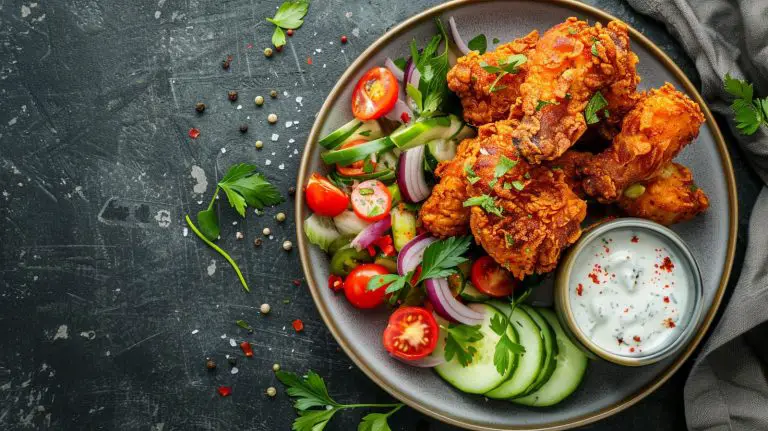
![glossy saucy consistency curry, [chili soy chicken]](https://tastycookingaroma.com/wp-content/uploads/2024/04/almostawake21_glossy_saucy_consistency_curry_chili_soy_chicke_f005f0d9-98f1-4956-8251-e7b98f5e61fc_2-768x430.jpg)
